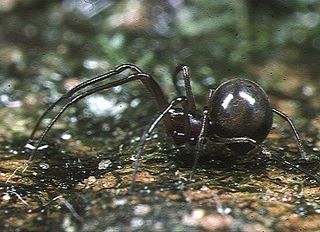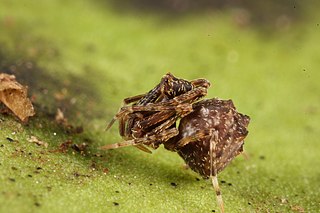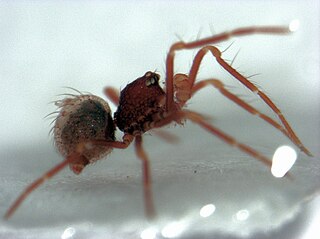
Anapidae is a family of rather small spiders with 231 described species in 58 genera. It includes the former family Micropholcommatidae as the subfamily Micropholcommatinae, and the former family Holarchaeidae. Most species are less than 2 millimetres (0.079 in) long.

Archaeidae, also known as assassin spiders and pelican spiders, is a spider family with about ninety described species in five genera. It contains small spiders, ranging from 2 to 8 millimetres long, that prey exclusively on other spiders. They are unusual in that they have "necks", ranging from long and slender to short and fat. The name "pelican spider" refers to these elongated jaws and necks used to catch their prey. Living species of Archaeidae occur in South Africa, Madagascar and Australia, with the sister family Mecysmaucheniidae occurring in southern South America and New Zealand.

Holarchaea is a genus of South Pacific araneomorph spiders in the family Anapidae, and was first described by Raymond Robert Forster in 1955. As of May 2019 it contains only two species, H. globosa and H. novaeseelandiae, but there may still be undescribed species in New Zealand.

The Micropholcommatinae are a subfamily of araneomorph spiders in the family Anapidae. They were previously treated as the family Micropholcommatidae. Micropholcommatins are extremely small, with body lengths typically between 0.5 and 2 mm. They are usually found among leaf litter or moss.

Austrarchaea is a genus of Australian assassin spiders first described by Raymond Robert Forster & Norman I. Platnick in 1984.
Algidiella is a genus of spiders in the family Anapidae. It was first described in 2010 by Rix & Harvey. As of 2017, it contains only one species, Algidiella aucklandica.
Austropholcomma is a genus of spiders in the family Anapidae. It was first described in 2010 by Rix & Harvey. As of 2016, it contains 2 species.
Eperiella is a genus of spiders in the family Anapidae. It was first described in 2010 by Rix & Harvey. As of 2016, it contains 2 species.
Epigastrina is a genus of spiders in the family Anapidae. It was first described in 2010 by Rix & Harvey. As of 2016, it contains 3 species, all from Tasmania.
Gigiella is a genus of spiders in the family Anapidae. It was first described in 2010 by Rix & Harvey. As of 2016, it contains 2 species.
Guiniella is a genus of spiders in the family Anapidae. It was first described in 2010 by Rix & Harvey. As of 2017, it contains only one species, Guiniella tropica, found in New Guinea.
Micropholcomma is a genus of spiders in the family Anapidae. It was first described in 1927 by Crosby & Bishop. As of 2017, it contains 8 Australian species.
Normplatnicka is a genus of spiders in the family Anapidae. It was first described in 2010 by Rix & Harvey. As of 2016, it contains 3 species from Australia and from Chile.
Patelliella is a genus of spiders in the family Anapidae. It was first described in 2010 by Rix & Harvey. As of 2017, it contains only one species, Patelliella adusta, found on Lord Howe Island.
Raveniella is a genus of spiders in the family Anapidae. It was first described in 2010 by Rix & Harvey. As of 2017, it contains 9 Australian species.
Taliniella is a genus of spiders in the family Anapidae. It was first described in 2010 by Rix & Harvey. As of 2016, it contains 2 species, both from New Zealand.

Taphiassa is a genus of spiders in the family Anapidae. It was first described in 1880 by Simon. As of 2017, it contains 6 species.

Tinytrella is a genus of spiders in the family Anapidae. It was first described in 2010 by Rix & Harvey. As of 2017, it contains only one species, Tinytrella pusilla, found in New Zealand.






